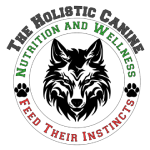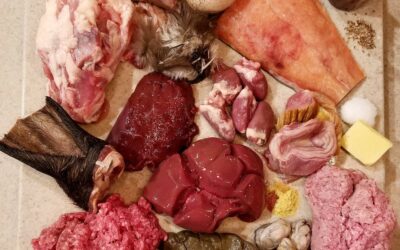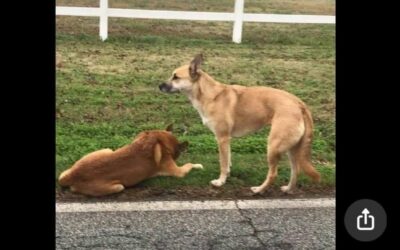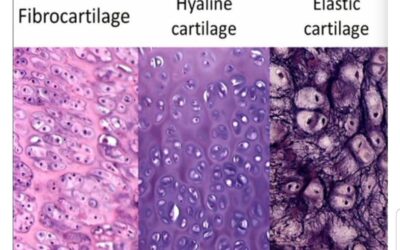Regular health assessments and keeping an eye on your dog’s poop could mean the difference between health and serious illness or disease
Feeding your dog a fresh raw species-appropriate diet that is balanced and varied is the foundation for optimal health cultivation along with maintaining peak cellular performance and organ function throughout the entirety of your dog’s life. While diet is the foundation for health and health maintenance, there are numerous other factors that can contribute to the breakdown of health or inability to build health within the body. Environment, stress, chemical exposure, mental stimulation, vaccines, parasites, exercise and daily activities, fresh air, and water type, for example, all play a major role in either contributing to health or to the breakdown of health. For this reason, paying careful attention to your dog and being observant of changes is vitally important if your desire is to maintain peak cellular function and keep physical, mental, and emotional stress to a healthy minimum.
While it would be wonderful if our dogs could verbally communicate any health concerns, pain, difficulties, fears, and changes, the burden is, unfortunately, left to our observing eye. Along with yearly exams from a holistic or a functional-medicine veterinarian, observing and examining your pet daily is also important. This can be done easily while petting your dog, during regular grooming sessions, when out on walks or in the yard for exercise & “potty” breaks, at mealtimes, and even when your pet is sleeping or lounging around. Take note of any changes or unusual behaviors. Your daily observations and exams should include the following. Look for:
Skin
- dryness/dandruff
- redness
- itching/scratching/biting skin
- raised red bumps
- raised red and inflamed patches
- hot spots
- hair loss
- odor
- oily or greasy skin
- fleas and ticks
- sores and broken skin
- clear discharge, oozing or pus
- crusty areas
- lumps under the skin
Coat
- dry coarse/brittle fur (some breeds have coarse fur, for this I refer to atypical)
- oily or greasy coat
- lackluster
- balding whether in patches or in one particular area
- excessive shedding
- odor
- flea poop
- crusty and clumped together fur
Food
- increase or decrease in food intake
- sudden pickiness
- lack of interest in mealtime
- difficulty swallowing
- gagging
- vomiting after meals
- swelling around mouth, nose, eyes
- sudden weight loss
- sudden weight gain
Water
- increase in water intake without increase in urination
- excessive urination
- excessive thirst
- stark decrease in water intake
- choking after drinking
Oral
- tooth loss
- red swollen gums
- bleeding gums
- tooth or gum infection
- cracked tooth
- bad breath
- dry gums
- difficulty chewing
- excessive salivation/drooling
- having difficulty eating or inability to eat
Eyes & nose
- discharge from eyes or nose (may be clear, white, yellow, thin, or thick)
- squinting eyes/sensitivity to light
- excessive sneezing
- dry nose
- redness around eye membrane
- stark change in eyesight
- formation of eye cloudiness or cataracts
Ears
- odor
- redness
- itching
- shacking head consistently
- holding head to one side
- holding one or both ears in odd position
- shying away when head is touched
- difficulty hearing
Paws
- redness on toes or pads
- sores between toes or on pads
- cracked or bleeding pads
- torn, cracked, or infected nail
- odor
- nails that are too long (this is important for correct posture and gait!)
- brittle peeling nails
- lumps or growths on toes or pads
Activity
- fatigue
- appearing depressed or withdrawn
- lack of energy or motivation
- sudden decrease in daily activity
- sleeping more
- lack of interest in daily activities or family dynamic
- grunting when getting up from lying down
- sudden increase in activity coupled with hyperactivity, anxiety, whining, acting “clingy,” pacing, increased water intake
Exercise
- refusing walks
- difficulty maintaining normal walking distance
- less activity in the yard
- having difficulty running
- limping
- lameness
- panting excessively (when heat is not an issue)
- loss of interest in playtime
- coughing, gagging
Respiratory
- breathing heavily
- panting excessively
- coughing/gagging
- wheezing
- deep sighing
- short quick breaths
- mucous or phlegm discharge from mouth and/or nose
Body
- wincing, whining, or grunting when touched or pick-up
- grunting when getting up from lying position
- inability to step up, jump up, or jump down
- no longer using stairs or walking slowly up stairs
- masses or hard lumps under the skin or in deep tissue
- holding head down
- holding head to one side, stiff neck
- joint pain or swelling
- changes in bark or vocal sounds
Mental
- sudden aggression
- sudden possessiveness
- growling when approached or touched
- shying or flinching when about to be petted or touched
- not wanting to be bothered
- anxiety
- chewing on household items
- destructive behavior
- peeing in or marking house or kennel area
- pooping in house despite being house broken
- suddenly ignoring commands
- bullying
- fear or sudden shyness
So what now? If you discover your dog has any of the concerns or conditions listed above, it’s time to pay close attention. Be aware of any additional changes or further developments. Some of the concerns and conditions above can advance rapidly within 24 hours while others may have been there or have been occurring for months before you noticed. Some of the more minor issues often rectify themselves within 24 to 48 hours. But how will you know if a concern is serious? When in doubt, contact your licensed veterinary professional at the earliest possibility.
One of the best ways to look for potential health concerns is by observing your dog’s stools on a daily basis. As unpleasant or disgusting as this may sound, your dog’s poop is a window into the “goings-on” and internal functioning of your dog’s body. I cannot stress enough how important it is to pay regular attention to stools. There are three indicators to observe, 1) consistency, 2) color, and 3) odor. All of these are clues that can give you important information about organ function, system health, nutrient absorption, food sensitivities, dietary imbalances, digestive issues such as incapability and insufficiency, internal parasites, inflammation, chronic conditions, cancer, and more.

Your dog’s stools should be fully formed, nearly odorless, slightly moist, and a chocolate brown to slightly “orangish” color. You should not see any undigested food or particles, mucous, a muddy or greasy appearance, parasites, blood or any other color unless something was consumed that would naturally cause color change. Nor should there be a strong offensive odor.
Consistency, color, and odor are often windows into the internal functioning of your dog’s body. These signs may be indications of an acute issue or something bigger brewing that can spell illness or disease. Let’s take a closer look at stools to learn what can be gleaned from consistency, color, and odor. The lists below begin with the most minor causes that will rectify themselves (likely with minor adjustments on your part) to the most serious that require a trip to the veterinarian.
CONSISTENCY
Oily/greasy/slimy stools
- Too much dietary fat
- Consumption of cooked fats (this can cause pancreatitis)
- High consumption of plant fats (many dogs cannot digest or utilize plant fats)
- Fat malabsorption
- Intestinal inflammation
- Bowel infection
- Giardia
- Small bowel bacteria overgrowth
- Biliary issue
- Pancreatic insufficiency
- Pancreatitis
- Pancreatic disease
Pebbles, hard stool
- Too much bone
- Feeding dry kibble/food with insufficient moisture (can lead to a chronic state of cellular dehydration)
- Not enough food intake
- Low water intake
- Feeding insoluble fiber
- Feeding too much fur
- Acute dehydration
- Hip dysplasia and arthritis pain in hips, legs, or back can create bowel movement difficulty due to inability to hold the correct squat position (dogs in pain may hold back evacuating their bowels)
- Obstruction, impaction
- Chronic dehydration
Muddy
- Dietary change
- Consumed something disagreeable
- Food intolerance or sensitivity
- Intestinal inflammation
- Rectal polyps
- Pancreatic strain or insufficiency
- Beginning of a liver condition
- Viral infection
- Giardia
- Tumor(s)
Watery, diarrhea
- Dietary change
- Too much organ meat
- Transition to raw that was too fast
- Food sensitivity, intolerance, or allergy
- Stress
- Consumed or drank something with pathogenic bacteria
- Intestinal inflammation
- Irritable Bowel Syndrome (IBS)
- Giardia or parasites
- Small intestine bacteria overgrowth (SIBO)
- Viral infection (parvo)
- Pancreatic insufficiency
- Inflammatory Bowel Disease (IBD)
- Liver condition
- Tumor(s)
- Cancer
Mucous coated formed stool
- Intestinal irritation
- Food sensitivity or allergy
- Bowel inflammation
- Irritable Bowel Syndrome (IBS)
- Acute colitis
- Chronic colitis
Mucous with mushy stool
- Consumed something disagreeable
- Food sensitivities with intestinal irritation
- Parasites
- Food allergy
- Bowel inflammation
- Viral infection, Parvo
- Irritable Bowel Syndrome (IBS)
- Acute colitis
- Chronic colitis
- Inflammatory Bowel Disease (IBD)
COLOR (and appearance)
White chalky, pale yellow chalk
- Too much bone (constipation is a possibility if not reduced)
- Too much calcium (this is dangerous if consistent)
Pale
- Gallbladder blockage or issue
- Biliary issue
- Liver condition
Yellow
- Bile, food intolerance
- Biliary condition
- Giardia
- Liver condition
Orange
- Consumed food such as carrots and pumpkin puree
- Biliary duct condition
- Liver condition
Green
- Consumed foods such as spirulina, greens powder, pureed leafy greens
- Gallbladder concern
Grey
- Biliary condition
- Blocked bile duct
- Gallbladder concern
- Pancreatic condition
- Liver condition
Red
- Severe food intolerance
- Rectal fissure or injury
- Large intestine bleeding
- Inflammatory Bowel Disease (severe)
- Internal bleeding in the lower GI tract
- Bleeding intestinal ulcer
- Ruptured intestinal tumor
- Perforated bowel
- Cancer
Black, tar-like
- Small intestine bleeding
- Internal bleeding in the upper GI tract
- Parasites (intestinal) infestation
- Intestinal infection
- Ulcer
- Internal bleeding in upper GI tract
- Polyps
- Tumor(s)
- Cancer
Speckled (white or tan)
- Parasites
- Tapeworms
- Roundworms
Food particles
- Consuming food that cannot be digested
- Feeding foods that are not species-appropriate
Foreign objects or particles
- Swallowed pieces of a toy
- Swallowed chewed-up sticks, whole pebbles, stones, etc.
- Pica
ODOR
As strange as this may sound, the odor of your dog’s stools can indicate a very serious health condition. Now, I am not suggesting you smell your dog’s bowel movements because in the case of smelly dog poop, you do not need to be too close to get an unpleasant whiff. You will know immediately as soon as the poop hits the air. “Ode de poo-poo” will fill your surroundings with its malodorous fragrance. What can these potent stink-bombs indicate?
- Malabsorption (very common!)
- Food sensitivities or allergies
- Consumption of a non-edible
- Intestinal inflammation
- Worms
- Parasites
- Bacterial infection
- Viral infection
- Colitis
- Irritable Bowel Syndrome
- Inflammatory Bowel Disease
- Cancer
And the not-so-obvious
- Kidney disease
- Heartworm
- Gallbladder condition
- Pancreatic condition
- Heart disease
- Thyroid disease
Daily examinations are a necessary part of health maintenance. While these concerns and conditions cannot be verbally expressed, the above signs or symptoms are the blaring alarm that something is amiss. The burden is left to us. Occasional changes in poop is normal and is rarely ever a need for concern. However, if stool changes have not cleared up in a day or two or is consistently abnormal, it’s time to seek professional health care advice, support, testing, and intervention. In the case of a virus, such as Parvo, or a bacterial infection, time is of the essence. If you suspect your dog may have a health concern, call your holistic veterinarian immediately to schedule an appointment. Don’t wait until it’s too late.
©2019 Kimberly Lloyd, PhD, BCHHP. Cert Raw Dog Food Nutritionst



